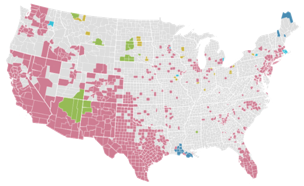Immigrant Population Shifts Outside Traditional Areas

When you think about where immigrant populations usually live, which states do you think of? California, New York, or Texas?
While that may have been true in the past, over the past decade there has been a gradual shift away from these obvious destinations. More and more immigrant populations are moving to states and cities that would have not been traditionally considered a hub for immigrant populations.
Where Are They Going?
Over the last decade, the limited-English population has grown by more than 25% in 21 states. And according to the US Census, “61 counties crossed the threshold of having a population of more than 5% limited-English speakers.”
The top ten states with the highest growth rates of LEP populations are:
- Nevada
- North Carolina
- Georgia
- Arkansas
- Tennessee
- Nebraska
- South Carolina
- Utah
- Washington
- Alabama
A Change in the Landscape
We will still continue to see major immigration to the usual destinations, but those destinations are expanding further and further across the United States. The Washington Post created a map that highlights where 10% or more of the population speaks a language other than English at home. The map shows where immigrants have settled and are continuing to settle beyond states like California, Texas, and New York.
According to the Migration Policy Institute, “While many LEP individuals are still attracted to the historic immigrant-destination states of California, Texas, New York, New Jersey, Florida and Illinois, significant numbers are opting to settle in nontraditional destinations in the Southeastern, Southwestern, and Northwestern United States.”
Why are they going?
The short and sweet answer: jobs.
William H. Frey, a Brookings Institution demographer, has studied the immigrant migration within the United States. “The fast growth of construction and low-skilled jobs, plus the general affordability of parts of the South for upwardly mobile Hispanics, has made the South a key destination,” Dr. Frey said.
Audrey Singer, a senior fellow at the Brookings Institution, also noted that while immigrants are still attracted to the traditional immigrant hubs like New York, Chicago and Los Angeles – mostly to join friends and relatives already settled there – more and more immigrants are following the jobs and moving to the South and West where the central cities are less dense.